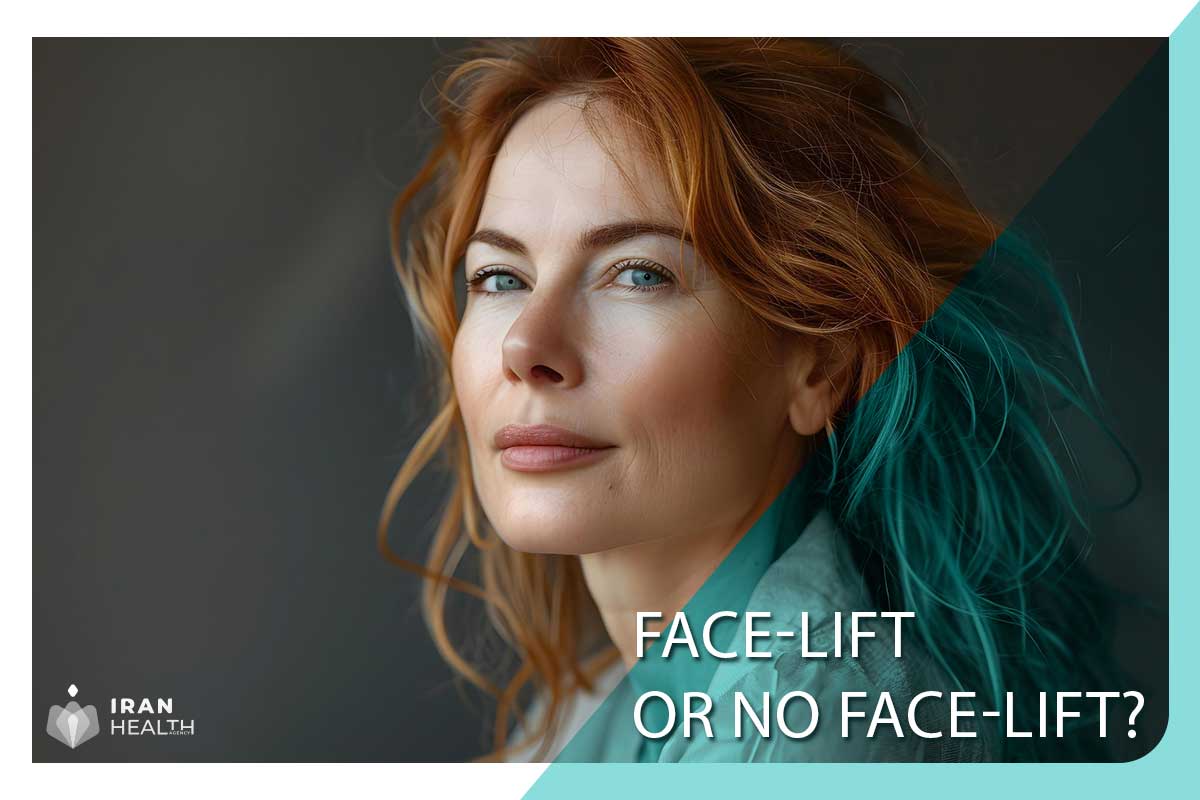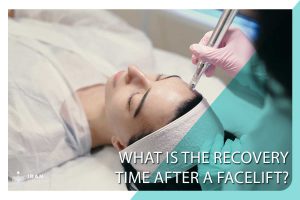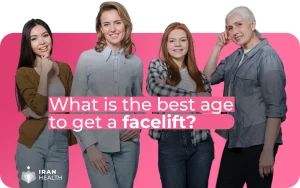Have you ever looked in the mirror and wished you could turn back the clock on your face? Do you feel like your appearance does not match your inner vitality and energy? If so, you are not alone. Many people struggle with the signs of aging in their face, such as sagging skin, deep wrinkles, jowls, and droopy eyelids. These changes can affect your self-esteem, confidence, and social opportunities.
But what can you do about it? Should you opt for a face-lift, a surgical procedure that can create a more youthful appearance in your face by removing excess skin, smoothing out wrinkles, and tightening facial tissues? Or should you try one of the many nonsurgical alternatives that claim to offer similar results without the risks, costs, and recovery time of surgery? In this blog post, we will help you answer these questions and decide if you need a face-lift or if you can achieve your goals with nonsurgical methods.
you can see: facelift surgery in iran
Facelift vs. Non-Surgical Options: The Ultimate Cheat Sheet
| Feature | Facelift | Non-Surgical Options |
| Procedure Type | Surgical | Minimally invasive or non-invasive |
| Anesthesia | General | Topical or local, sometimes none |
| Recovery Time | 2-6 weeks | 1-7 days, minimal downtime |
| Results | Dramatic, long-lasting (5-10 years) | Subtle, temporary (6 months – 2 years), require repeat treatment |
| Cost | Higher ($5,000 – $25,000+) | Lower ($500 – $3,000 per treatment) |
| Risks | Higher (infection, scarring, anesthesia complications) | Lower (bruising, swelling, temporary discomfort) |
| Best for: | Deep wrinkles, sagging skin, significant volume loss | Fine lines, wrinkles, mild skin laxity, specific concerns (e.g., lips, brows) |
| Examples: | Traditional facelift, mini facelift, neck lift | Botox, fillers, laser treatments, micro needling, threads |
What is a face-lift and what are the benefits and drawbacks?
A facelift, or rhytidectomy, as it is most commonly known, is a form of cosmetic surgery used to make the face appear younger by cutting excess skin, flattening wrinkles, and tightening the facial tissues. A facelift can be described as an upper two-thirds face correction that includes cheeks, jawline, chin, and neck.
A face-lift can also act alone or with another procedure such as eyelid surgery, brow lift, or fat transfer to achieve a more satisfactory result. The facelift is usually a surgery that can either be under general anesthesia or local anesthesia with sedation, and the length of the surgery will depend on the amount of work to be done.
The surgeon cuts along the hairline, around the ears, and under the chin, then lifts and reshapes the skin and the subcutaneous tissues. The extra skin is removed and the places where the incisions were made are closed with sutures or staples. A face-lift can provide several benefits, such as:
- Improving the contour and definition of the face and neck
- Reducing the appearance of sagging skin, deep wrinkles, jowls, and double chin
- Restoring a more youthful and refreshed look
- Enhancing the harmony and balance of the facial features
- Boosting the self-esteem, confidence, and social opportunities of the person
potential drawbacks
However, a face-lift also has some potential drawbacks, such as:
- Anesthesia risks, such as allergic reactions, nausea, or breathing problems
- Bleeding, infection, or scarring at the incision sites
- Facial nerve injury, which can cause temporary or permanent weakness or numbness in the face
- Fluid accumulation or hematoma, which can cause swelling, pain, or bruising
- Deep vein thrombosis, cardiac and pulmonary complications, which can be life-threatening
- Dissatisfaction with the results, which may not meet the expectations or preferences of the person
- High cost, which may not be covered by insurance or may require additional procedures to correct or maintain the outcome
- Long and painful recovery, which may take several weeks or months and may interfere with the daily activities and social life of the person
What are the nonsurgical alternatives to face-lifts (benefits and drawbacks)?
These days, folks are finding they don’t always need to get surgery to help their face look fresher and younger. Some clever alternatives can improve wrinkles, sagging, spots, or loss of volume without going under the knife. I like to think of these as falling into three buckets: injectables, energy devices, and skincare products.
Injectables are substances the doctor puts under your skin with a needle to achieve different goals. Some popular ones are fillers to fill in lines and restore fullness, and Botox to relax muscles that cause wrinkles or fat transfers to plump up the face using your fat. Then there are handy devices that use different types of energy like lasers, ultrasound, or radiofrequency waves to encourage collagen growth, tighten things up, or improve skin tone and texture. No cuts or incisions are needed!
Finally, there are some amazing skincare ingredients like retinoids and antioxidants that can deeply nourish skin or gently peel away damage. Used consistently in creams, serums, and treatments, they promote regeneration for smoother, glowier, and firmer skin over time.
potential benefit:
- Being less invasive, risky, and painful than surgery
- Having lower costs and shorter recovery times than surgery
- Being more customizable and flexible than surgery
- Having fewer side effects and complications than surgery
- Being more suitable for people who are not good candidates for surgery or who have mild to moderate signs of aging
potential drawbacks
- Having less dramatic and lasting results than surgery
- Requiring multiple sessions or maintenance treatments to achieve and maintain the desired outcome
- Having variable outcomes depending on the skill and experience of the provider, the quality and type of the product or device, and the individual response of the person
- Having possible allergic reactions, infections, bruising, swelling, or asymmetry as side effects
- Not being able to address the underlying causes of facial aging, such as the loss of bone, muscle, and fat, or the excess skin
How to decide if you need a face-lift or if you can achieve your goals with nonsurgical methods?
The decision to have a face-lift or a nonsurgical alternative is a personal one that depends on many factors. There is no one-size-fits-all answer, and the best option for you may not be the best option for someone else. However, here are some questions that you can ask yourself to help you decide:
- What are your main concerns and goals for your face? Do you want to address specific areas or the whole face? Do you want to improve the shape, volume, or texture of your face? Do you want to look younger, fresher, or more natural?
- What are your expectations and preferences for the outcome? How much improvement do you want to see? How long do you want the results to last? How comfortable are you with the possibility of scarring, complications, or dissatisfaction?
- What is your budget and time frame for the procedure? How much can you afford to spend? How much time can you spare for the consultation, preparation, procedure, and recovery? How often are you willing to repeat or maintain the treatment?
- What is your health and medical history? Do you have any medical conditions or medications that may affect your healing or increase your risks? Do you have any allergies or sensitivities to any products or devices? Do you have any skin conditions or infections that may affect your outcome?
- What is your lifestyle and habits? Do you smoke, drink, or use drugs? Do you have a healthy diet and exercise routine? Do you protect your skin from the sun and environmental damage? Do you follow a good skincare regimen?
Based on your answers to these questions, you can weigh the pros and cons of each option and choose the one that best suits your needs and wants. You can also consult with a board-certified plastic surgeon or a qualified aesthetic provider who can assess your face, listen to your concerns and goals, and recommend the most appropriate option for you. Remember, the decision is yours, and you should feel comfortable and confident with whatever you choose.
Conclusion
In conclusion, facelifts and nonsurgical alternatives are both viable options to improve the appearance of your face and make you look younger and more refreshed. However, they have different benefits and drawbacks, and the best option for you depends on your goals, expectations, budget, health, and lifestyle. You should do your research, ask yourself some questions, and consult with a professional before making your decision. Ultimately, the choice is yours, and you should be happy and satisfied with whatever you choose.
What do you think? Have you had a face-lift or a nonsurgical alternative? What was your experience and outcome? Would you recommend it to others? Share your thoughts and opinions in the comments below.



